Achievement of Curriculum for Excellence (CfE) Levels 2018-19
Results of the achievement of curriculum for excellence (CFE) levels 2018 to 2019.
Chapter 3: Achievement of CfE Levels by SIMD
The 2016/17 figures in this chapter were revised on 30 April 2020 (see chapter 9.4).
- The gap between the proportion of primary pupils (P1, P4 and P7 combined) from the most and least deprived areas who achieved their expected level in literacy has reduced since 2016/17.
- The gap between the proportion of primary pupils (P1, P4 and P7 combined) from the most and least deprived areas who achieved their expected level in numeracy remained stable between 2017/18 and 2018/19, slightly below the 2016/17 level.
- The gap between the proportion of S3 pupils from the most and least deprived areas who achieved their expected level in literacy has remained broadly stable throughout 2016/17, 2017/18 and 2018/19.
- The gap between the proportion of S3 pupils from the most and least deprived areas who achieved their expected level in numeracy reduced between 2016/17 and 2017/18 and again between 2017/18 and 2018/19.
This chapter provides an overview of achievement of CfE Levels data by Scottish Index of Multiple Deprivation (SIMD). It provides information on literacy and numeracy for P1, P4, P7 and S3 as well as for P1, P4 and P7 combined. Full details (including all organisers and all SIMD quintile categories) are available in the supplementary tables which can be found in the supporting files associated with this document (http://www.gov.scot/ISBN/9781839603488).
The figures shown in Chart 4 and Chart 5 provide four of the 11 key measures used to measure the poverty related attainment gap. In 2017 the Scottish Government consulted on proposals for measuring the poverty related attainment gap and milestones towards closing it; focusing on the impact of the education system as a whole and using a range of measures that reflect key stages of the learner journey and the breadth of issues that can impact on attainment. The four measures are:
- Percentage of P1, P4 and P7 pupils combined achieving expected Level in Literacy;
- Percentage of P1, P4 and P7 pupils combined achieving expected Level in Numeracy;
- Percentage of S3 pupils achieving Third Level or better in Literacy and;
- Percentage of S3 pupils achieving Third Level or better in Numeracy.
When considering data by SIMD as a measure of deprivation, it is important to note that the data shows the difference between young people living in the most or least deprived areas. What SIMD data does not show is the difference between young people from poor or rich backgrounds.
The charts below show achievement of CfE results by SIMD since 2016/17. The robustness and consistency of these statistics have increased over time. This should be kept in mind when making comparisons between years, see Chapter 9.1.4.2.
3.1 Achievement of CfE Levels by SIMD – P1 pupils
Chart 1 shows the proportion of P1 pupils who achieved the expected levels in literacy and numeracy for pupils in the most and least deprived areas.
The P1 attainment gap in literacy remained stable between 2016/17 and 2017/18 at 20.2 percentage points. In 2018/19 it fell to 19.2 percentage points. The proportion of P1 pupils achieving the expected literacy levels has increased for both pupils in the most and least deprived areas. The gap has narrowed in 2018/19 because the proportions increased by slightly more for pupils from the most deprived areas.
The P1 attainment gap in numeracy has reduced slightly each year, from 14.0 percentage points in 2016/17 to 13.3 percentage points in 2017/18 and to 13.0 percentage points in 2018/19. The proportion of P1 pupils achieving the expected numeracy levels has increased by more for pupils in the most deprived areas than for pupils in the least deprived areas.
Chart 1: Percentage of P1 pupils achieving expected Level in Literacy and Numeracy by SIMD, 2016/17 to 2018/19a
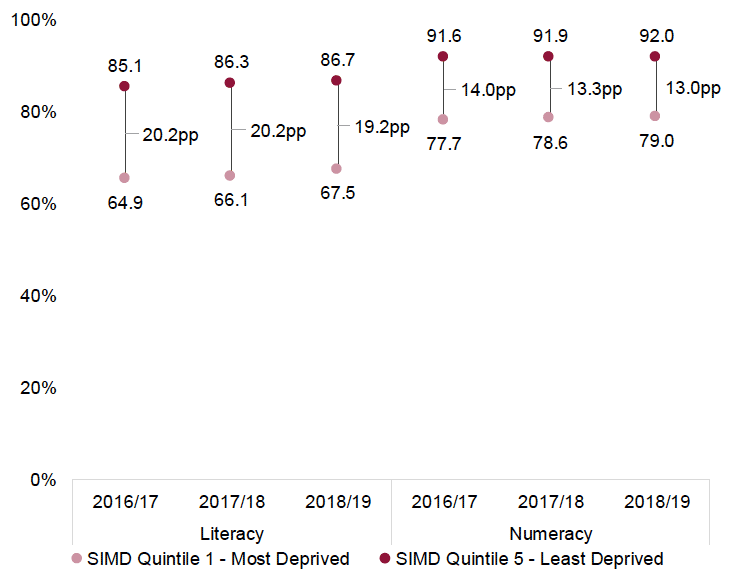
pp = percentage point difference between most and least deprived
1. Based on SIMD 2016 for all years. More information on the Scottish Index of Multiple Deprivation can be found at: http://www.gov.scot/Topics/Statistics/SIMD.
a. The robustness and consistency of these statistics have increased over time. This should be kept in mind when making comparisons between years, see Chapter 9.1.4.2.
3.2 Achievement of CfE Levels by SIMD – P4 pupils
Chart 2 shows the proportion of P4 pupils who achieved the expected levels in literacy and numeracy for pupils in the most and least deprived areas.
The P4 attainment gap in literacy reduced from 22.6 percentage points in 2016/17 to 21.7 percentage points in 2017/18 and has reduced slightly further in 2018/19 to 21.5 percentage points. Over this period the proportion of P4 pupils achieving the expected literacy levels has increased for both pupils in the most and least deprived areas. The gap has narrowed because the proportions increased by slightly more for pupils from the most deprived areas.
The attainment gap in P4 numeracy has remained broadly stable between 2016/17 and 2018/19 at around or just over 18 percentage points. Over this period the proportions of pupils achieving the expected numeracy levels have increased by similar amounts for pupils from both the most and least deprived areas.
Chart 2: Percentage of P4 pupils achieving expected Level in Literacy and Numeracy by SIMD, 2016/17 to 2018/19a
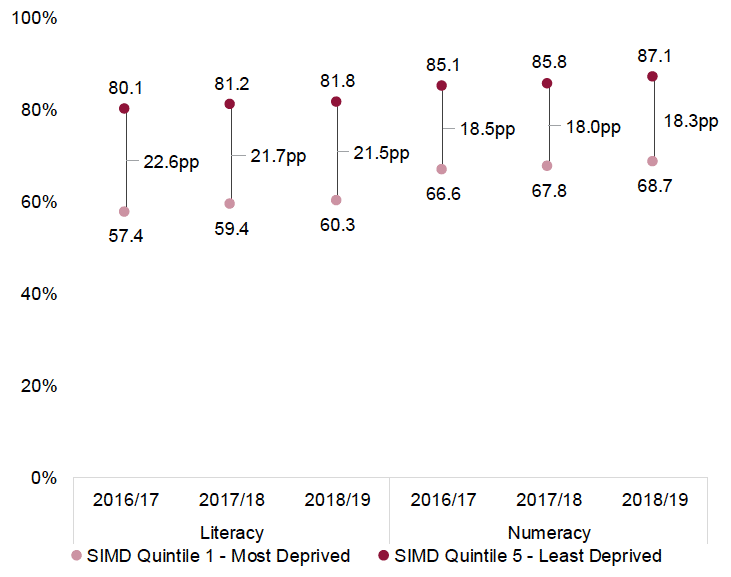
pp = percentage point difference between most and least deprived
1. Based on SIMD 2016 for all years. More information on the Scottish Index of Multiple Deprivation can be found at: http://www.gov.scot/Topics/Statistics/SIMD.
a. The robustness and consistency of these statistics have increased over time. This should be kept in mind when making comparisons between years, see Chapter 9.1.4.2.
3.3 Achievement of CfE Levels by SIMD – P7 pupils
Chart 3 shows the proportion of P7 pupils who achieved the expected levels in literacy and numeracy for pupils in the most and least deprived areas.
The P7 attainment gap in literacy reduced slightly from 23.8 percentage points in 2016/17 to 23.4 percentage points in 2017/18 and has reduced further in 2018/19 to 21.5 percentage points. Over this period the proportion of P7 pupils achieving the expected literacy levels has increased for both pupils in the most and least deprived areas but between 2017/18 and 2018/19 the increase was greater for pupils from the most deprived areas resulting in the gap narrowing.
The attainment gap in P7 numeracy reduced from 20.9 percentage points in 2016/17 to 19.7 percentage points in 2017/18 and reduced again in 2018/19 to 19.3 percentage points. Over this period the proportions of pupils achieving the expected numeracy levels have increased for pupils from both the most and least deprived areas but the increase has been greater for pupils from the most deprived areas.
Chart 3: Percentage of P7 pupils achieving expected Level in Literacy and Numeracy by SIMD, 2016/17 to 2018/19a
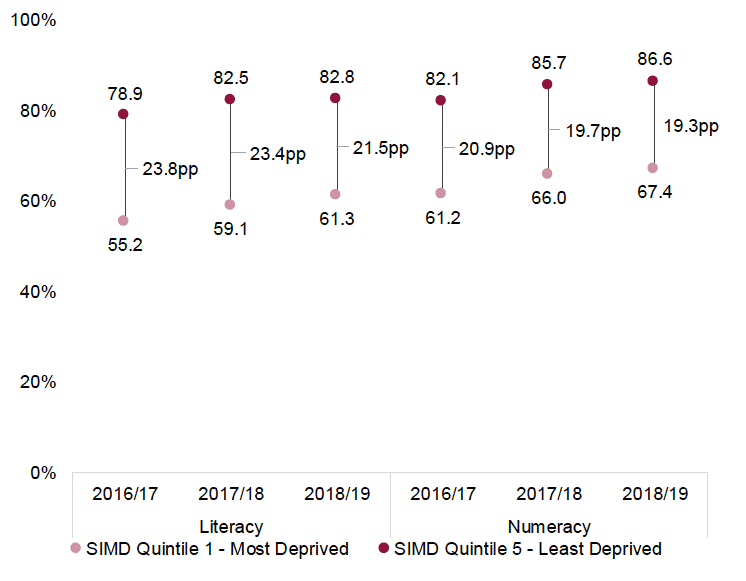
pp = percentage point difference between most and least deprived
1. Based on SIMD 2016 for all years. More information on the Scottish Index of Multiple Deprivation can be found at: http://www.gov.scot/Topics/Statistics/SIMD.
a. The robustness and consistency of these statistics have increased over time. This should be kept in mind when making comparisons between years, see Chapter 9.1.4.2.
3.4 Achievement of CfE Levels by SIMD – P1, P4 and P7 pupils
Chart 4 provides information for P1, P4 and P7 pupils combined. The attainment gap in literacy reduced slightly from 22.1 percentage points in 2016/17 to 21.6 percentage points in 2017/18 and has reduced further to 20.7 percentage points in 2018/19.
The numeracy attainment gap for P1, P4 and P7 pupils combined reduced from 17.6 percentage points in 2016/17 to 16.8 percentage points in 2017/18 and has remained at this level in 2018/19.
The proportions of P1, P4 and P7 pupils combined achieving the expected literacy and numeracy levels have increased for both pupils in the most and least deprived areas. Where the gaps have narrowed it is because the proportions increased by slightly more for pupils from the most deprived areas.
Chart 4: Percentage of P1, P4 and P7 pupils (combined) achieving expected Level in Literacy and Numeracy by SIMD, 2016/17 to 2018/19a
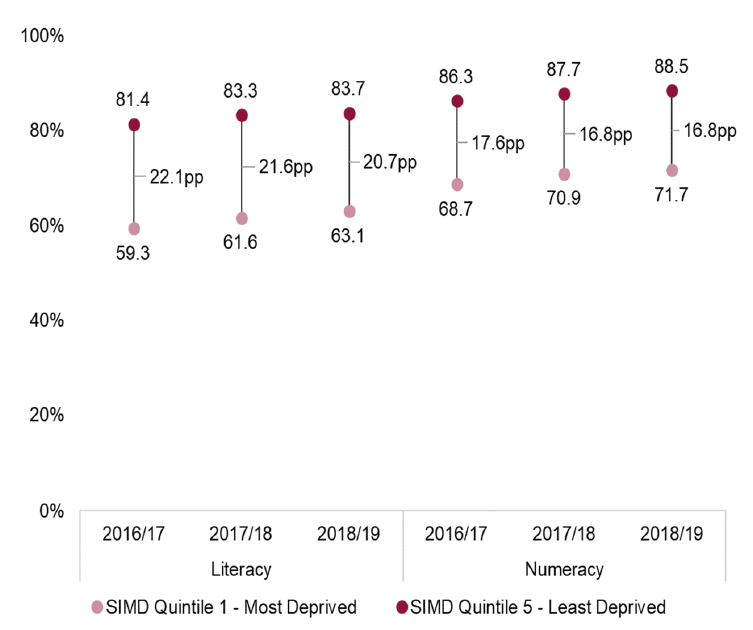
pp = percentage point difference between most and least deprived
1. Based on SIMD 2016 for all years. More information on the Scottish Index of Multiple Deprivation can be found at: http://www.gov.scot/Topics/Statistics/SIMD.
a. The robustness and consistency of these statistics have increased over time. This should be kept in mind when making comparisons between years, see Chapter 9.1.4.2.
3.5 Achievement of CfE Levels by SIMD – S3 pupils
Chart 5 shows the proportion of S3 pupils who achieved Third Level or better in literacy and numeracy, for pupils in the most and least deprived areas. The chart shows that the proportion of S3 pupils who achieved the expected level in literacy has remained broadly stable since 2016/17, for pupils from both the most and the least deprived areas. As a result the S3 pupils attainment gap in literacy has also remained broadly stable, falling from 13.6 percentage points in 2016/17 to 13.3 percentage points in 2017/18 before increasing to 13.8 percentage points in 2018/19.
The S3 pupils attainment gap in numeracy has reduced from 14.9 percentage points in 2016/17 to 14.0 percentage points in 2017/18 and to 13.5 percentage points in 2018/19. The proportion of S3 pupils who achieved Third Level or better in numeracy has increased for pupils form both the most and the least deprived areas but has increased by more for those from the most deprived areas.
Chart 5: Percentage of S3 pupils achieving Third Level or better, by SIMD, for Literacy and Numeracy, 2016/17 to 2018/19a
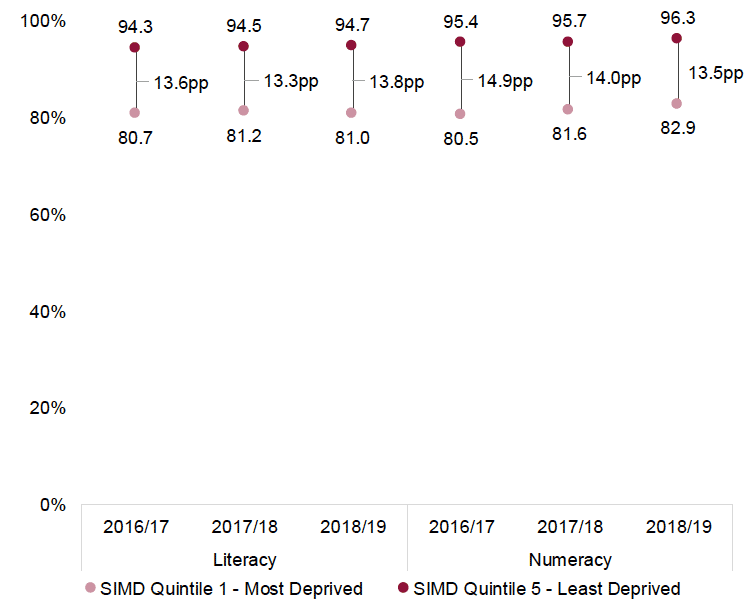
pp = percentage point difference between most and least deprived
1. Based on SIMD 2016 for all years. More information on the Scottish Index of Multiple Deprivation can be found at: http://www.gov.scot/Topics/Statistics/SIMD.
a. The robustness and consistency of these statistics have increased over time. This should be kept in mind when making comparisons between years, see Chapter 9.1.4.2.
Contact
Email: Andrew.White@gov.scot
There is a problem
Thanks for your feedback